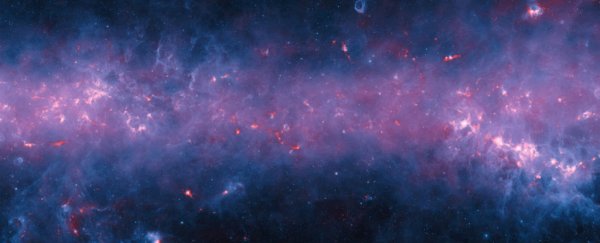When you look up at the night sky, you only see a tiny, tiny part of what's actually laid out in front of you, thanks to obstructions like cloud cover and light pollution. But the good news is that the European Southern Observatory (ESO) exists solely to pierce through that foggy veil and reveal the vast Universe beyond.
The team's latest feat is completing the APEX Telescope Large Area Survey of the Galaxy (ATLASGAL), which gives us a whole new image of the Milky Way in all its glory - and it's an incredible four times larger than any other image of our galaxy.
The new image was captured by the Atacama Pathfinder Experiment telescope (APEX), which lies 5,100 metres above sea level in Chile's Atacama region on the Chajnantor Plateau. Besides being completely beautiful, the map covers an area 140 degrees long and three degrees wide, and the information it holds is explained in more than 70 different papers.
This survey is also the first to capture the Galactic Plane - where the majority of our galaxy's mass is located - at sub-millimetre wavelengths, which allows scientists to image gas and dust clouds with temperatures just above absolute zero. "Cooled to just a fraction above absolute zero, the camera detects tiny emissions from bands of dark gas and dust that can't be viewed by the naked eye," Erin Blakemore explains at Smithsonian.com.
To capture the image, the team used a bunch of super-sensitive instruments such as the Large Bolometer Camera (LABOCA), which "measures incoming radiation by registering the tiny rise in temperature it causes on its detectors and can detect emission from the cold dark dust bands obscuring the stellar light", says the ESO.
These results were also strengthened by data collected by the European Space Agency's (ESA) Planck satellite, which allows astronomers to scan a larger portion of the sky at greater detail.
So besides looking stunningly beautiful, what can researchers learn from this survey? Leonardo Testi, a member of the ATLASGAL team, explains:
"ATLASGAL has allowed us to have a new and transformational look at the dense interstellar medium of our own galaxy, the Milky Way. The new release of the full survey opens up the possibility to mine this marvellous dataset for new discoveries. Many teams of scientists are already using the ATLASGAL data to plan for detailed ALMA follow-up."
Since ATLASGAL is able to pick up extremely cold dust clouds, the survey also offers a new look at forming stars. And one of the coolest things to think about whenever images like these are released is the fact that we're actually looking at these objects in the distant past.
Since light can only travel so fast and the objects in them are so far away, images of the Milky Way - even brand new ones - probably do not reflect what's actually there anymore. In other words, looking at this survey is a lot like staring through a portal to past.
Past or not, ATLASGAL will enable researchers all over the world to discover how our galaxy functions and what it's composed of. As surveys get more detailed, we learn more about our galactic past and where our Solar System might go in the future, and that's something we need - and definitely want! - to know about.
Click here to see the full, zoomable image of the Milky Way.
